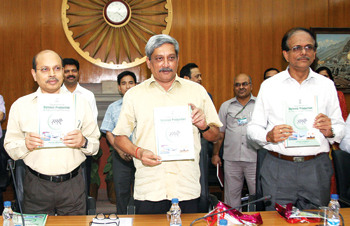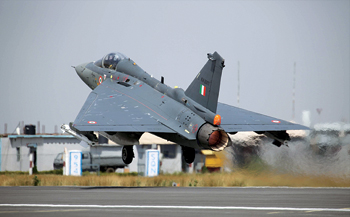INDIAN ARMED FORCES CHIEFS ON
OUR RELENTLESS AND FOCUSED PUBLISHING EFFORTS

SP Guide Publications puts forth a well compiled articulation of issues, pursuits and accomplishments of the Indian Army, over the years

I am confident that SP Guide Publications would continue to inform, inspire and influence.

My compliments to SP Guide Publications for informative and credible reportage on contemporary aerospace issues over the past six decades.
- Prime Minister witnesses 'Bharat Shakti' – a Tri-Services Firing and Manoeuvre Exercise in Pokhran, Rajasthan
- Interim Defence Budget 2024-25 — An Analysis
- Union Defence budget 2024
- Prime Minister Modi Commemorates Indian Navy Day in a Grand Ceremony
- Prime Minister Modi Flies in the LCA Tejas
- New Chapter in India-Italy Defence Ties
- Airpower beyond Boundaries
Two-year achievements — Tackle brass tacks

The extravaganza post completion of the present government on May 26 highlighting achievements in the past two years was expected, as a lot has certainly happened in this period. The economy is looking up, the foreign policy progressing taking into account the fluid dynamics of geopolitics, including further cementing of the China-Pakistan anti-India axis. In the defence sector, the major change has been the ‘Make in India’ initiative albeit its effect to be felt would pan over some years.
Some achievements attributed to Defence Minister Manohar Parrikar on social media include:



- 100 per cent conversion of offset obligation in 2014-15, as against 63.7 per cent conversion between 2008-13;
- Growth in value of production of ordnance factory (OF) and defence public sector undertakings (DPSUs) over the last two years;
- Growth in defence exports over the last two years;
- Indigenously designed and developed light combat aircraft (LCA) Tejas is under production;
- Testing of Dhanush — the 155mm X 45-calibre artillery gun system is under advanced stages;
- List of military stores requiring NOC, and SOP for the same have been made public, which removes ambiguity and promotes consistency;
- Government to support domestic defence industry with 90 per cent of design and development project funding; MSMEs to be given special preference;
- Exchange rate variation protection made applicable for Indian private sector, at par with DPSUs for all categories of defence acquisitions;
- Dependence of the forces on foreign firms for procurement has reduced by more than 20 per cent year-on-year in last two years;
- In the last three years, the Indian Army placed over 75 per cent of its capital acquisition orders with Indian firms, and,
- All naval ships and submarines on order are being constructed in Indian shipyards, in line with the spirit of ‘Make in India’.
There is no denying that the Defence Minister has demonstrated his resolve to advance India’s defence but the above needs to be more closely examined what the ground position is, which is summarised as: conversion of offset obligation — full details of contracts signed are not available beyond broad financial details like date of contract signing, value of the main contract and offset amount. The name of the Indian offset partners (IOPs), amount and kind of offsets received by each, and the detailed timeframe for execution of each offset contract are missing, in absence of which accurate economic analysis is not possible. There is also the point about services in offsets, introduced in 2012 and removed in 2013 due Rs. 392 crore paid through Indian companies in the name of software services as kickbacks in the AgustaWestland helicopter scam.
Past Comptroller and Auditor General of India (CAG) reports too are more fault-finding, not certifying that any individual offset contract has worked as per contractual terms. Therefore, the claim that 100 per cent conversion of offset obligation has been affected during 2014-15 may not be the true picture and need to be seen in this backdrop. The new policy has revised the offset limit from Rs. 300 crore to Rs. 2,000 crore but more transparency is required to evaluate the actual percentage of the conversion; growth in production value of OF and DPSUs — growth in production value is a simplistic statement. What is important is whether it is holistic, what percentage, and more importantly how is this growth contributing to bridge the ‘critical voids’ of the military, of which there is little evidence; growth in defence exports — good sign but much more catching needs to be done; LCA Tejas under production — there is news of the Tejas being inducted this July in the first IAF squadron. Compare the news just six months the news was that while the IAF was to procure 120 x Tejas (70 per cent parts and assemblies being imported) the aircraft was still to undergo 43 improvements out of the 57 maintainability weaknesses detected, which was estimated to take another three years at least, further prolonging development of the aircraft that began in 1983. Hopefully, in the hurry to show progress some of these 43 improvements required will not be postponed for addressing post induction.
Dhanush testing under advanced stage — this is a good indigenous gun though the Defence Research and Development Organisation (DRDO) has produced this after tweaking the ToT of Bofors on which it sat for decades. Considering that no gun has been inducted in the artillery for the past 25 years, not only will the Dhanush need to be produced in mass numbers the interim critical voids need to be addressed as importantly; military stores requiring NOC and SOP for same made public — good initiative; support domestic defence industry with 90 per cent of design and development project funding — this is a good initiative but considering that there is glut in the indigenous technological base, the voids of DPP 2016 including benchmarking of the ‘strategic partners’ must be resolved early keeping in mind that no foreign partner will invest in India unless he can make adequate profit; MSMEs to be given special preference — good policy but implementation is the key; exchange rate variation protection made applicable for Indian private sector at par with DPSUs for all categories — good policy; dependence of the forces on foreign firms for procurement, has reduced by more than 20 per cent — the approving authority is the Defence Acquisition Council (DAC). While claiming this as an achievement, what needs to be examined is how this has affected the critical voids of the forces.
Take for example the critical deficiency of bullet proof jackets in the Indian Army which has shot up to over 3,50,000 while Indian firms are exporting this item to armies and security forces of some 200 countries; Indian Army placed over 75 per cent of capital acquisition orders with Indian firms — same as last comment; all naval ships and submarines on order are being constructed in Indian shipyards, in line with the spirit of ‘Make in India’ — in line with the new policy. Navy presently has 47 warships under construction in various domestic shipyards, eventually aiming at a 198 warship and 600 aircraft by 2027. Building six Scorpene submarines indigenously through ToT under Project 75 is already running four years behind schedule and suffering from rising costs. Project 75(I), involving localised production of six air-independent propulsion submarines under the ‘Buy and Make (Indian)’ procurement category, was canceled and then revamped under ‘Make in India’. Fresh estimates indicate it may take 10-12 years before any submarine in this class enters service. Overall, while it is good to talk of achievements, there is need to address the brass tacks.
The views expressed herein are the personal views of the author.





